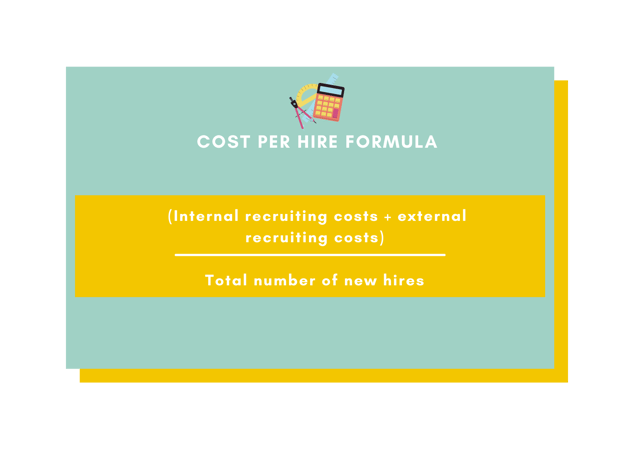Cost Per Hire - How to Calculate it?
Cost per hire, often referred to simply as CPH, is a useful recruiting and HR metric that helps organizations make more strategic decisions (and investments) in recruitment processes.
How to calculate cost per hire?
The cost per hire calculation can vary from industry to industry, and equally so between organizations. That being said, it has been standardized by leaders in the HR space including the Society of Human Resource Management and the American National Standards Institute.
To calculate your cost per hire, take the sum of your internal and external recruiting costs, and divide them by the total number of new hires in a given time period. It's important to note that cost per hire calculations generally don’t include costs incurred after a hire (e.g. training costs).

In the formula above, internal costs refer to the internal staff, capital, and organizational/process costs associated with recruiting. This includes things like:
- Salaries for internal talent acquisition teams
- Salary costs and time spent by hiring managers
- Learning and development costs
External costs as they relate to cost per hire generally refers to expenses allocated to external resources during the recruitment process. These include things like:
- Fees for recruiting agencies or freelancers
- Job board fees
- Costs for drug testing and background checks
- Employer branding activities like job fairs
- Fees for software like applicant tracking systems
- Relocation expenses
Finally, the total number of hires indicated in the formula generally includes all internal and external hires. This can include both full-time and part-time hires.
The cost per hire formula generally excludes costs associated with external workers like consultants, internal transfers, and employees that came on board during the merger or acquisition of another company.
Does cost per hire matter?
The cost per hire metric can be tremendously effective in helping HR teams justify, create and adhere to effective recruiting budgets.
That being said, over-analyzing cost per hire figures can lead to distractions on strategic recruiting as well as recruitment quality. For example, an increase in a company’s cost per hire isn’t necessarily a bad thing: if you hired a much higher volume of high-performing workers, you would likely think of this as a success. Other things, like investments in new effective technologies such as Applicant Tracking Systems, would unfairly inflate this figure. (as, for example, the best performers might be expensive or take longer to higher).
Cost per hire, like many other HR KPIs, is also not(that) useful when analyzed in isolation; it’s only one piece of the bigger picture. A high cost per hire shouldn’t always be viewed as a bad thing. It could actually indicate a strong recruitment function!
(Some) best practices for cost per hire data
While cost per hire data is very useful for recruitment optimization, there are some things to make sure you’re doing to make the best use of the figure.
- Examine it regularly: a frequent assessment of cost per hire is important to adequately optimize the process, identify room for improvement, and understand whether things like increases in cost are good or bad.
- Don’t analyze costs in isolation: cost per hire data should certainly be looked at at the organizational level, but data at the departmental and positional levels is important.
- Look at sources: by looking at recruitment sources, you can understand which are the most effective. An effective HR dashboard can help here.
- Contextualize! Other HR metrics, like quality of hire and time-to-fill a position can help contextualize cost per hire. Look for correlations!
The last word
Calculating cost per hire is helpful for many things, not the least of which is optimizing your recruitment process. There is no one-size-fits-all approach to the metric, so make sure you’re accounting for all the variables (what roles you’re recruiting for, where you’re strategically investing, demand, and organizational size).


